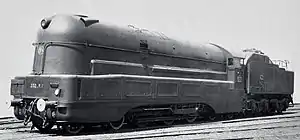SNCF 232.P.1
SNCF 232.P.1 was an experimental prototype high-pressure steam locomotive ordered by the Chemins de fer du Nord, but delivered to the Société nationale des chemins de fer français (SNCF) in 1939. It was the first and only member of SNCF's first class of 4-6-4 or Hudson type of locomotives.
| SNCF 232.P.1 | |||||||||||||||||||||||||||||||||||||||||||||||||||||||
|---|---|---|---|---|---|---|---|---|---|---|---|---|---|---|---|---|---|---|---|---|---|---|---|---|---|---|---|---|---|---|---|---|---|---|---|---|---|---|---|---|---|---|---|---|---|---|---|---|---|---|---|---|---|---|---|
 | |||||||||||||||||||||||||||||||||||||||||||||||||||||||
| |||||||||||||||||||||||||||||||||||||||||||||||||||||||
| |||||||||||||||||||||||||||||||||||||||||||||||||||||||
| |||||||||||||||||||||||||||||||||||||||||||||||||||||||
| |||||||||||||||||||||||||||||||||||||||||||||||||||||||
Origins
The locomotive was ordered by on 9 March 1936 by the Chemins de fer du Nord in an attempt to improve on the power output and fuel consumption of the conventional steam locomotive.
The project involved three of the French big-four locomotive manufacturers: Société alsacienne de constructions méchaniques (SACM); Fives-Lille; and Schneider et Cie. It also received assistance from the Swiss Locomotive and Machine Works (SLM) of Winterthur.
Description
It was decided to fit the locomotive with a high-pressure boiler and multiple small steam motors to drive each axle
The boiler was in two parts: the main, rear part, was a water tube boiler pressed to 60 kgf/cm2 (5.88 MPa; 853 psi) (a conventional boiler was limited to 25 kgf/cm2 or 2.45 MPa or 356 psi). The forward part was a conventional fire-tube boiler pressed to 20 kgf/cm2 (1.96 MPa; 284 psi) and served as a feed-water heater.
There were six, three-cylinder, 500-metric-horsepower (370 kW; 490 hp) steam motors, which were attached, two per axle, to the driving axles by gearing. They had a maximum rotational speed of 1000 rpm, which would give the locomotive a theoretical maximum speed of 148 km/h (92 mph). The small motors were less bulky, had a higher power-weight ratio and were more efficient. Their use eliminated the need for a crank axle, and enable the use of small diameter driving wheels of 1,550 mm (5 ft 1 in), and shortened the length of the locomotive
The Direction du Matériel et de la Traction (service MT) (Rolling Stock and Traction Department) believed that the small motors could easily be disconnected and would not immobilise the locomotive.
Due to the absence of connecting rods, the locomotive had outside frames and an integral fairing.
Service history
The locomotive left the Graffenstaden works of SACM in the early days of 1939 and testing started immediately. However, the outbreak of World War II quickly interrupted these tests; the locomotive was sent to workshops at Oullins where it went into storage. The tests resumed in 1943, and after a presentation at the Oullins Workshops in 1946 and a series of measurements taken on the Vitry-sur-Seine test plant in 1947, the locomotive went back into store. Placed awaiting authorisation for retirement in 1948, it was finally withdrawn in 1949.
Conclusion
The design had to answer the desire to increase the efficiency or reduce the consumption for the same power. However, the delay caused by the World War II, the fact that the boiler was more complex, and the difficulty of maintaining the main boiler at very high pressure made the gains obtained, viz., fuel economy in the order of 30%, meant that the design had no impact on future steam locomotives.
Tender
The tender which was attached to the locomotive was one of the bogie tenders of type 36.B which held 36,000 litres (7,900 imp gal; 9,500 US gal) of water and 9 tonnes (8.9 long tons; 9.9 short tons) of coal (in this case 36.B.9).
References
- Davies, John (November 2003). Société Nationale des Chemins de fer Français Locomotive List 1938–1975. Woodbridge, Queensland: Dr. John Davies. ISBN 0-9585541-2-9.
- Constant, Olivier. Encyclopédie du matérial moteur SNCF, Tome 2: Les locomotive à vapeur depuis 1938 (in French). Betschdorf: Editions Publitrains eurl. ISSN 1267-5008.